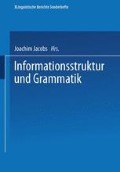Abstract
The focus of the present paper is word order variation within languages. There is a widespread view in the literature that the selection among truth-conditionally equivalent word order variants permitted by the grammar is determined primarily by considerations of “information structure”, i.e. pragmatic-semantic notions such as predictability or importance (Givon 1983, 1988), agency, definiteness (Jacobs 1988), etc. It is generally agreed that syntactic weight or length is also relevant in performance, but the extent of this relevance is usually seen as being limited to a handful of structures that are particularly difficult for processing, such as center embeddings and the positioning of finite clause complements (cf. e.g. Grosu & Thompson 1977, Dryer 1980).
I have benefited greatly from discussions with a number of individuals while conducting the research reported here, especially Kaoru Horie and Stephen Matthews at USC, and the members of the Constituent Order Group of the European Science Foundation Programme in Language Typology, especially Katalin Kiss, Beatrice Primus, Anna Siewierska and Maria Vilkuna. Valuable feedback was also received from linguists at the Free University of Berlin, when portions of this material were presented there in October 1989. None of the individuals mentioned necessarily agrees with all of my conclusions. I would also like to acknowledge, with gratitude, financial support from the following sources that has made possible the ongoing research project from which the results reported here are derived: a summer stipend from the National Endowment for the Humanities (FT-34150); a small grant from the European Science Foundation; and a grant from the University of Southern California Faculty Research and Innovation Fund (FRIF).
Access this chapter
Tax calculation will be finalised at checkout
Purchases are for personal use only
Preview
Unable to display preview. Download preview PDF.
References
Chomsky, N. (1981): Lectures on Government and Binding. Dordrecht: Foris.
Dryer, M.S. (1980): “The positional tendencies of sentential noun phrases in universal grammar”. The Canadian Journal of Linguistics 25, 123–195.
Dryer, M.S. (1988a): “Object-verb order and adjective-noun order: Dispelling a myth”. In: Papers in Universal Grammar: Generative and Typological Approaches, ed. by J.A. Hawkins H.K. Holmback, Lingua Special Issue 74, Nos. 2 /3, 185–217.
Dryer, M.S. (1988b): “Universals of negative position”. In: Studies in Syntactic Typology, ed. By M. Hammond, E.A. Moravcsik J.R. Wirth. Amsterdam: John Benjamins, 93–124.
Emonds, J.E. (1976): A Transformational Approach to English Syntax: Root, Structure-Preserving, and Local Transformations. New York: Academic Press.
Givon, T., ed. (1983): Topic Continuity in Discourse: A Quantitative Cross-Language Study. Amsterdam: John Benjamins.
Givon, T. (1988): “The pragmatics of word order: Predictability, importance and attention”. In: Studies in Syntactic Typology, ed. by M. Hammond, E.A. Moravcsik J. Wirth. Amsterdam: John Benjamins, 243–284.
Grosu, A. S.A. Thompson (1977): “Constraints on the distribution of NP clauses”. Language 53, 104–151.
Haider, H. (1986): “Who is afraid of typology?” Folia Linguistica 20, 109–146. Hawkins, J.A. ( 1983 ): Word Order Universals. New York: Academic Press.
Hawkins, J.A. (1984): “A note on referent identifiability and co-presence”. Journal of Pragmatics 8, 649–659.
Hawkins, J.A. (1986): A Comparative Typology of English and German: Unifying the Contrasts. Austin: University of Texas Press, and London: Croom Helm (Routledge).
Hawkins, J.A. (1990): “A parsing theory of word order universals”. Linguistic Inquiry 21, 223–261. Hawkins, J.A. (1991a): “Innateness and function in language universals”. In: The Evolution of
Human Languages, ed. by J.A. Hawkins M. Gell-Mann. Reading, MA: Addison-Wesley. Hawkins, J.A. (1991b): “On (in)definite articles: Implicatures and (un)grammaticality prediction”. Journal of Linguistics 27. 2.
Hawkins, J.A. (to appear): A Performance Theory of Order and Constituency. Cambridge: Cambridge University Press.
Hawkins, J.A. A. Cutler (1988): “Psycholinguistic factors in morphological asymmetry”. In: Explaining Language Universals, ed. by J.A. Hawkins. Oxford: Basil Blackwell, 280–317.
Hawkins, J.A., K. Horie S. Matthews (in prep.): “Pragmatic information status and syntactic weight in free word order”.
Jacobs, J. (1988): “Probleme der freien Wortstellung im Deutschen”. Sprache und Pragmatik. Arbeitsberichte 5. Lund, 8–37.
Keenan, E.L. (1978): “The syntax of subject-final languages”. In: Syntactic Typology, ed. by W.P. Lehmann. Austin: University of Texas Press, 267–327.
Koopman, H. (1984): The Syntax of Verbs. Dordrecht: Foris.
Lehmann, W.P. (1978): “The great underlying ground-plans”. In: Syntactic Typology, ed. by W.P. Lehmann. Austin: University of Texas Press, 3–55.
Marslen-Wilson, W.D. L.K. Tyler (1980): “The temporal structure of spoken language understanding”. Cognition 8, 1–71.
Müller-Gotama, F. (1991): “A typology of the syntax-semantics interface”. University of Southern California, Ph.D. dissertation.
Primus, B. (1989): “Parameter der Herrschaft: Reflexivpronomina im Deutschen”. Zeitschrift für Sprachwissenschaft 8, 53–88.
Primus, B. (to appear): “A performance-based account of topic positions and focus positions”. In: Performance Principles of Word Order, ed. by J.A. Hawkins. Working Papers of the European Science Foundation Programme in Language Typology.
Rohdenburg, G. (1974): Sekundäre Subjektivierungen im Englischen und Deutschen: Vergleichende Untersuchungen zur Verb-und Adjektivsyntax. Bielefeld: Comelson-Velhagen und Klasing.
Vennemann, T. (1974): “Theoretical word order studies: results and problems”. Papiere zur Lin-guistik 7, 5–25.
Author information
Authors and Affiliations
Editor information
Editors and Affiliations
Rights and permissions
Copyright information
© 1992 Springer Fachmedien Wiesbaden
About this chapter
Cite this chapter
Hawkins, J.A. (1992). Syntactic Weight Versus Information Structure in Word Order Variation. In: Jacobs, J. (eds) Informationsstruktur und Grammatik. Linguistische Berichte Sonderhefte, vol 4. VS Verlag für Sozialwissenschaften, Wiesbaden. https://doi.org/10.1007/978-3-663-12176-3_7
Download citation
DOI: https://doi.org/10.1007/978-3-663-12176-3_7
Publisher Name: VS Verlag für Sozialwissenschaften, Wiesbaden
Print ISBN: 978-3-531-12294-6
Online ISBN: 978-3-663-12176-3
eBook Packages: Springer Book Archive

